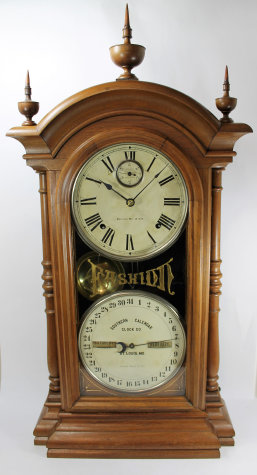

537. $1200
Ansonia “Colonel”, ca. 1914. A 61-inch time-only, weight-driven clock with an 18-inch dial,
in refinished black walnut with a rather light finish. The door glass is old, the dial glass new. The dial has been repainted,
the hands are correct. The case style and door framing differ slightly from the catalog drawing and may be year-to-year variation. I believe the bottom of the base has been replaced. The pendulum bob has been polished to death, the brass weights are fine. The unsigned movement is running and keeping time. I can’t exclude the possibility that this is a newer case with some original
parts, such as the dial, hands, and upper weight pulley assemblies; I can only find one previous sale, in 2003 for $4800, so there
isn’t much to compare to. An impressive and uncommon clock. Inquire about delivery options. $1200-$1800.

538. $250
Mark Lane shelf clock, 1828?-1835. A 29-inch column & splat case with good
veneer all around, two nice claw feet and newer turned feet in the back, bronzed columns with wear, and an old dial with an unusual
pattern in the middle. I think the splat is a replacement, as is the tablet and lower glass, which is now cracked in several
places. The dial glass is original, with original putty. Lane made cases and bought movements elsewhere; this one is a
standard 30-hour wooden movement with two old weights. We did not test it. Mark Lane clocks are not common; only three
listed in the Antique Clocks Price Guide. $250-$500.

539. $4500
Seth Thomas “Suez” double-dial calendar, ca. 1883. There is only one example of a Suez calendar
in the Antique Clocks Price Guide and it sold at RO Schmitt’s in 2011 for $7500. This one is a beauty, 44-inches in walnut with
a nice finish. I’m tempted to call the dials original, but with only a hint of flaking it is more likely they are an old repaint. The hands are correct, the nickel pendulum bob damascened, a beat scale behind it. The calendar rollers are old, yellowed, and
possibly original. The signed 8-day, time-and-strike spring movement is running and the RT Andrews calendar is advancing. You’ll not find one better, if you find another at all. $5000-$7500.
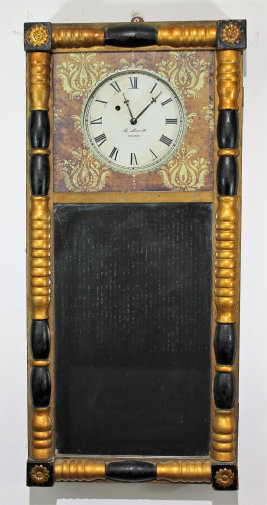
540. $500
B. Morrill New England Mirror clock, ca. 1830. Unfortunately, there are some serious deficiencies
with this clock. For starters, the dial surround is a print of a dial surround mounted on cardboard, rather than a reverse-painted
image. Ok, that can be fixed; many New England mirror clocks have repainted glasses. The dial glass is old, but not period. The mirror is also a replacement; old, but not period. Again, not uncommon. The front of the case has been repainted including
the formerly gilded columns, again not uncommon, and the corner rosettes replaced. Ok. The 29.5-inch case itself is very
old, and I would say original but the corners are not dove-tailed; as far as I can tell Morrill cases were dove-tailed. The
nicely painted and signed metal dial is on aluminum rather than iron. Ouch. The hands are period but not original. The square weight is a modern replacement, and the movement, while an early Morrill wheelbarrow movement, does not run and needs at
least one rebushing. So there you have it; a nice looking clock with numerous issues. These are the times when we wish
we were an eBay seller and could claim “I don’t know anything about clocks”. But we can’t. $500-$1000.
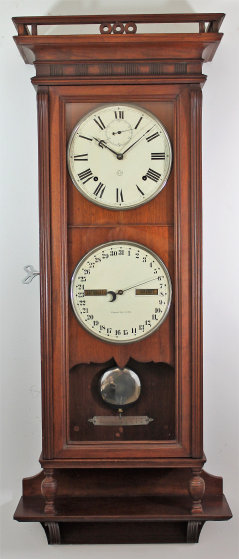
541. $850
Bradley & Hubbard “Topsey”, ca. 1867. One of the more desirable “blinking eye” clocks
of the late 1800’s, originally made by Bradley & Hubbard, and later copied by other makers. Here’s how you can tell an original
from a reproduction: originals have a lever movement with a fast-slow adjustment lever (the “smile”) at the top of the dial,
and have simple eyes with a black pupil on a white background. Beware of replacement “doll’s eyes” as they greatly reduce the
value. Not all blinking eye clocks are signed by B&H under the base; Topseys typically are not. Once you are sure
you have an original the next issue is the paint; most have lost considerable paint, and most, at a minimum, have been touched up. Some have been completely repainted; we have a stripped and repainted “Continental Soldier” in this auction (#619). Look for
jagged edges on missing paint, or underneath repaints. This example has been touched up, but most of the paint appears to us
to be original. The movement is an unsigned 30-hour lever movement (some were signed “Waterbury”, many were not) that is running,
and the original eyes move up and down as expected (note that in some reproductions the eyes move left to right). The dial has
been repapered and the hands are replacements. A new flat glass is puttied into the original bezel. She stands 16.5 inches
high. A superior example; a similar example sold at Schmitt’s in 2017 for $1300. $1200-$1500.

542. $3000
Seth Thomas “Parlor Calendar No. 10”, 1890. There are two versions of this model differing
in the trim at the top. It stands 36-inches tall in a refinished walnut case with burl trim and elaborate carvings. The
trim pieces all look to be original. Both dials have their original paint, now chipping on top, less so on the calendar dial,
with some inpainting. Both glasses are old. There is a signed 8-day time-and-strike, weight-driven lyre movement and an
RT Andrews calendar movement, all of which are running and striking. Good labels inside, including a service label from 1968. Two large iron weights included; the calendar roller papers have been replaced. Not a common calendar clock; Fontaine’s sold
one in March of last year for $3250. $3000-$3500.
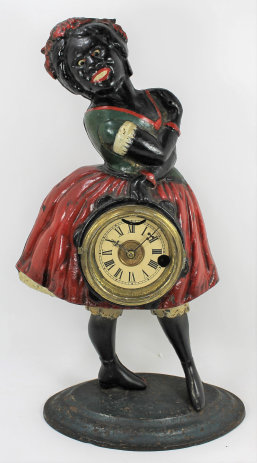
543. $420
Seth Thomas “Office Calendar No. 4”, 1870’s. A 28-inch double-dial perpetual calendar in rosewood
veneer with a very old and slightly crusty finish. No missing veneer, even on the buttons; the upper dial repainted and varnished,
the lower dial numbering touched up, with some flaking. Both glasses are old, the calendar roller papers yellowed but not too
dark. Label on the backside of the door. Eight-day time-only movement signed and running, calendar advancing but needs
adjustment. Not much to complain about here. We routinely sell these models for $450-$550.
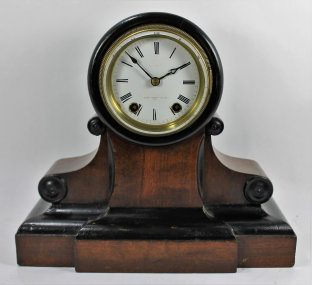
544. $125
Seth Thomas & Sons “No. 5000”, 1872. A 10.5-inch drumhead clock in walnut with ebonized
trim. The signed dial is porcelain behind a thick beveled glass. The minute hand is a replacement. It runs 15 days,
time and half-hour strike on a nickel bell. It is running sporadically and will likely need some TLC. I think the pendulum
is a replacement. Shown on page 1044 of Ly’s second volume on Seth Thomas clocks; I can’t find any sales records. $125-$175.

545. $500
Southern Calendar Clock Co. “Fashion No. 4”, 1875-1889. Good and bad here. The walnut
case is in great condition; the door glass is original with touched-up gold Fashion lettering, and there are good labels inside. The dial boards have gold incising, the finials are original but with new tips installed that are not to specs. Hands are correct,
the signed Seth Thomas movement is running like a champ and striking appropriately. The calendar movement is functional. That brings us to the bad: The zinc dials are seriously warped, sunken, and eroding from the back. They rub against the pendulum
and will probably need to be replaced. In addition, we have no pendulum for this clock. This clock has great potential
if you have the needed parts. $500-$800.
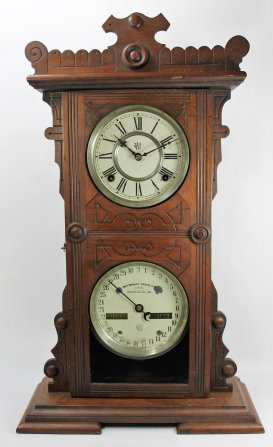
546. $350
Waterbury “Calendar No. 44”, ca. 1891. A 24-inch walnut case with an old finish, two signed,
painted metal dials with flaking to the calendar dial and some smearing of the numbering; correct hands, and two old glasses in the
bezels. Decent label behind plastic on the back. The clock is running, striking on the hour and half-hour, and the calendar
is advancing. Signed key included. These sell for about $400 on eBay. $350-$450.
